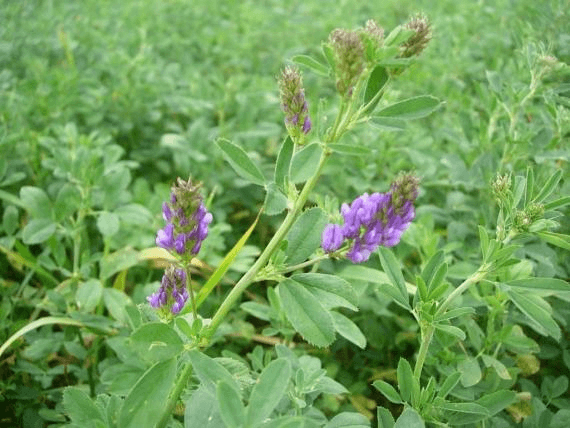Boost your milk by feeding Lucerne to your dairy cows

When it comes to affordable alternative protein solutions for your dairy cows, Lucerne (also called Alfalfa) is King! Lucerne provides a huge pack of nutrients (energy, protein, fibre, and minerals) to your dairy cows that are affordable and highly digestible.
Lucerne is a high yielding legume with deep roots which naturally fix nitrogen in the soil. Lucerne is usually established from seed. Lucerne is very sensitive and will not grow in soils that are heavy or get water logged easily. These conditions make its tap root to rot and die off.
A lot of care and nurturing is needed when growing lucerne. They are very sensitive and the crown needs to be protected when you are cutting it or grazing. They can last 4-5 years with good management. My take, its better to cut for or direct feeding yourself and avoid grazing. You will be spending money to grow these crops, so it’s better to be safe.
Some of the benefits of Lucerne are;
Source of energy: Lucerne contains high-quality energy that beneficial to your dairy cows. Providing energy in adequate amounts is usually difficult for most farmers in Kenya thus feeding our dairy cows with lucerne will help increase your milk and improve reproduction in high yielding dairy cows. Lucerne contains a highly digestible source of starches and pectins which are used by the rumen bacteria as a source of energy. Lucerne also contains a highly-digestible source of protein and neutral detergent fibre (NDF) which plays a role of increasing the amount of energy available to the cow when compared to grass hay.
Source of protein: Lucerne is mostly known for its protein reserves. It contains highly digestible protein and it a higher proportion of ruminal undegradable (RUP)/ bypass protein (25%-35%) RUPI than grass hays.
Greater mineral content: Lucerne contains a greater concentration of phosphorus, calcium potassium, sulfur, magnesium, iron, selenium and zinc than grass hays. Minerals are concentrated more and readily available in Lucerne forage harvested during its early stage of maturity. The concentration of minerals is greater and more available in alfalfa forage harvested at earlier stages of maturity. Minerals will however not make a big impact on performance and profitability as inorganic minerals purchased from agro-stores are relatively affordable.
If you are planning to grow lucerne and sell as a business, it is very important to follow the right steps on growing and harvesting. Lucerne quality greatly impacts milk production and this impact can even be felt by giving your dairy cows 2 kg of lucerne every day.
Feeding
- Do not feed fresh cut lucerne directly to cows. Give it time to wilt, this will prevent bloating in cows.
- If you are planning to graze your animals, use a rotational grazing system. Leave the farm unused for 30 to 35 days for re-growth. Graze your animals when the soil is dry to avoid root damage from trampling.
- Turn your excess lucerne into hay. TO get the best quality, cut your Lucerne in the early bud stage. Lucerne can also be dried and processed into pellets.
Lucerne is a great protein source and feeding it to your dairy cows will boost milk production and general performance when compared to grass alone. Go for it!
Watch out for our next article on steps for growing Lucerne.

Discover more from Graduate Farmer
Subscribe to get the latest posts sent to your email.








Hi Joseph.
Great content.
Thank you for sharing.